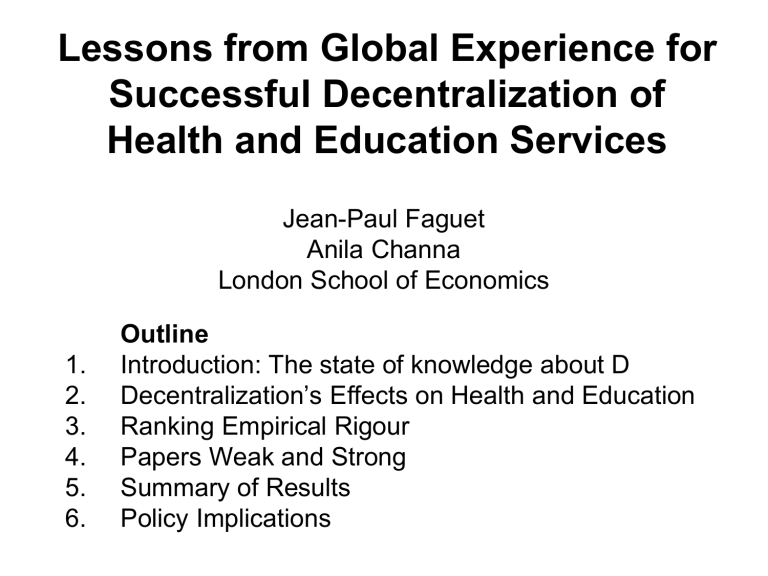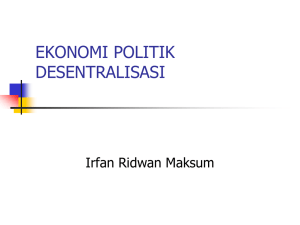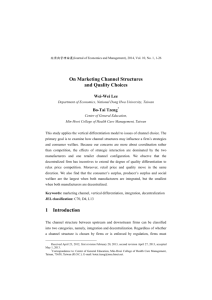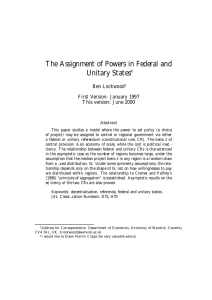Lessons from global experience for successful

Lessons from Global Experience for
Successful Decentralization of
Health and Education Services
Jean-Paul Faguet
Anila Channa
London School of Economics
Outline
1.
Introduction: The state of knowledge about D
2.
Decentralization’s Effects on Health and Education
3.
Ranking Empirical Rigour
4.
Papers Weak and Strong
5.
Summary of Results
6.
Policy Implications
1. Introduction
Decentralization is one of the broadest movements and most contentious policy issues in development.
• 80% - 100% of countries in the world experimenting with decentralization (World Bank).
• At the center of reform throughout Latin America,
Asia and Africa; also EU, UK & US.
• Scope of authority and resources devolved: Local governments spend 10 - 50% of total revenues
(Campbell, 2003)
What is Decentralisation?
(Rondinelli, et. al., 1984)
Deconcentration gives limited discretion to field agents.
Delegation transfers responsibilities to organizations outside the regular bureaucratic structure.
Devolution transfers power and resources to subnational units substantially outside CG control.
Privatization transfers functions and assets to the private sector.
These are not different forms of the same thing.
Fundamentally different institutional arrangements
establish different internal incentives
prompt very different behaviors.
This is a conceptual challenge in studying decentralization.
State of Knowledge
• Litvack et al. (1998): “One can prove, or disprove, almost any proposition about decentralization by throwing together some set of cases or data” (p.30).
• Shah, Thompson and Zou (2004): D sometimes improved, and other times worsened, service delivery, corruption, macroeconomic stability, and growth across a large range of countries.
• Treisman (2007): “To date there are almost no solidly established, general empirical findings about the consequences of decentralization” (p.250).
Bizarre paradox: After 50 years of policy experimentation and hundreds of studies we still know very little about whether D is a good or bad thing.
Education and Health – Examples
• Positive effects on education provision:
Galiani, Gertler and Schargrodsky (2008), Eskeland and
Filmer (2002), Parry (1997), Barankay and Lockwood
(2007).
• Positive effects on education and health:
Habibi et al. (2007).
• Negative effects on health services:
Akin, Hutchinson and Strumpf (2005).
• Negative effects on education, health, etc:
Crook and Sverrisson (1999), Smith (1985), and Solnick
(1996).
Education and Health
In summary , a large set of positive results re: education and health services are counterbalanced by a fewer but still compelling negative results.
Hard to conclude whether reform improves or degrades education and health.
Theoretical arguments for…
Decentralization can…
Arguments for i.
improve information re: local wants and needs ii.
increase citizen voice and participation iii.
improve government accountability
responsiveness iv.
deepen democracy v.
strengthen individual liberties vi.
improve economic performance vii.
increase policy stability viii.
reduce bureaucracy ix.
decrease public spending x.
decrease political tensions and the risk of civil war
“Closer to the people”
Theoretical arguments against
Arguments against i.
decrease efficiency in public goods production ii.
decrease the quality of policy-making iii.
increase graft and corruption iv.
facilitate elite capture of government v.
increase fiscal deficits and hence macroeconomic instability.
Theory provides a strong rationale
Bring government “closer to the people” better public goods, more effective government
• Smaller scale facilitates information, participation and accountability
Deepens democracy and lowers costs
• Local homogeneity vs. national heterogeneity
• Counteract centrifugal forces that cause political tensions/violence [Spain, UK]
Why don’t we know more?
• Conceptual confusion
What is D?
Where is it implemented?
• Non-rigorous empirical basis
Qual: Small-N and large-X
Quant: Cross country studies make for bad comparisons – too much RHS uncontrolled variation.
• Wrong question: “Is D good or bad?”
Contribution of this review
Conceptual confusion?
Decentralization = Devolution
Non-rigorous empirics?
Classify evidence by X: theme and Y: quality or rigor of the evidence Clear patterns emerge.
Themes
(1) Allocative efficiency (preference-matching)
(2) Technical efficiency
(3) Equity
Rigour
Very Strong
Studies with strong research designs that clearly identify causal effects and successfully address endogeneity problems.
Randomized control trials.
Strong
Research that is able to construct a reasonable comparison group and specifically addresses sources of endogeneity:
• Panel estimates in a fixed effects model while controlling for more than one socio-economic covariate, and more than one covariate from the health/education production function.
Quasi-experimental designs such as DID and IV.
Somewhat Strong
Attempts to construct a valid comparison group, but limited success in dealing with endogeneity.
Cross-sectional work with matching
Panel estimations with random effects or between effects.
Difference in differences lacking key identifying assumptions of parallel trends.
Weaker IVs and fixed effects with limited covariates.
Weak
Findings based on
• self-selected populations
• no valid comparison group
• omitted variable bias and other endogeneity problems.
Most cross-sectional work, especially single country cases.
Table 2: Rigor in the Evidence
Scale Allocative efficiency
Generally
Positive
Generally Insignificant or Negative Findings
▪ Hasnain (2008)
▪ Schwartz et al (2002)
-
Technical efficiency
Generally Positive
Findings
Generally
Insignificant or
▪ Treisman (2002)
Weak
-
-
-
▪ Hasnain (2008)
▪ Freinkman and
Plekhanov (2009)
▪ Di Gropello (2002)
▪ Jimenez and Paqueo
(1996)
▪ Lockheed and
Zhao (1993)
▪ Treisman (2002)
▪ Eskeland and Filmer
(2007)
▪ Arze del
Granado et al
(2005)
▪ Akin et al (2005) ▪ Asfaw et al (2007)
▪ Robalino et al (2001)
▪ Habibi et al (2003)
▪ Inchauste (2009)
▪ Khaleghian (2003)
Somewhat Strong
-
▪ Arze del
Granado et al
(2005)
-
-
▪ Aslam and Yilmaz (2011)
▪ Freinkman and Plekhanov
▪ Inchauste (2009)
(2009)
▪ Paes de Barros and
Mendonca (1998)
▪ King and Ozler (2000)
▪ Khattri et al (2010)
▪ Parker (2005)
▪ Di Gropello and Marshall
(2005)
▪ Gunnarsson et al
(2009)
▪ Jimenez and
Sawada (1999)
▪ Sawada and
Ragataz (2005)
Table 2: Rigor in the Evidence
Scale Allocative efficiency
-
▪ Faguet (2004)
▪ Skoufias et al (2011)
Technical efficiency
▪ Uchimura and Jutting
(2009)
Strong
-
-
▪ Faguet (2004)
▪ Skoufias et al
(2011)
-
-
-
▪ Galiani et al (2008)
▪ Faguet and Sanchez
(2008)
-
▪ Skoufias and Shapiro
(2006)
▪ Gertler et al (2011)
▪ Hanushek et al (2011)
-
Very Strong
-
-
-
-
▪ Duflo et al (2007)
-
▪ Glewwe and Maiga
(2011)
Rigorous evidence on technical efficiency is favorable.
Decentralization improves technical efficiency in education, health and SBM. Stronger methodologies show stronger effects.
Decentralization can enhance service delivery outcomes, from student test scores to infant mortality rates .
• More studies examine final outcomes, not policy outputs.
Outcomes more likely influenced by exogenous factors.
• Only a few studies explain the channel through which service delivery improves Limits policy implications for other decentralizers.
Evidence on allocative efficiency in health is negative.
Driven by externalities in health sector.
Local governments may match local preferences more efficiently while ignoring spillovers This reduces overall welfare.
But this is surmountable with conditional transfers, or with decentralizations that retain central control in areas with large externalities.
Evidence on allocative efficiency in education is positive, but few in number.
Decentralization
Equity is contingent
Elite capture is evident but by no means dominant.
Conventional wisdom that
Decentralization Efficiency
Centralization Equity is misleading, at least w.r.t. public goods delivery.
Important to understand existing hierarchical social structures , and then design D reforms around them to promote participation, accountability, and strong equalization transfers.
Political accountability and capacity building dominate as preconditions
Evidence supports strong political accountability and capacity building as enablers to successful decentralized service delivery .
Policy Implications
(i)
1. Good decentralization should improve technical efficiency in education and health.
Better quality and quantity or services
Better outcomes (e.g. literacy, infant mortality).
2. Good decentralization will increase allocative efficiency in education. In health too, if D includes conditional transfers and retained central authority in areas with large externalities.
Policy Implications
(ii)
3. Decentralization Efficiency and
Centralization Equity misleading w.r.t. public goods delivery.
Understand local hierarchical social structures, then design D reforms with participation and strong equalization transfers schemes.
4. Political accountability and capacity building dominate as preconditions. Decentralize down to lowest levels suited to particular services, s.t.
accountability can obtain. Then build capacity there actively and passively.






